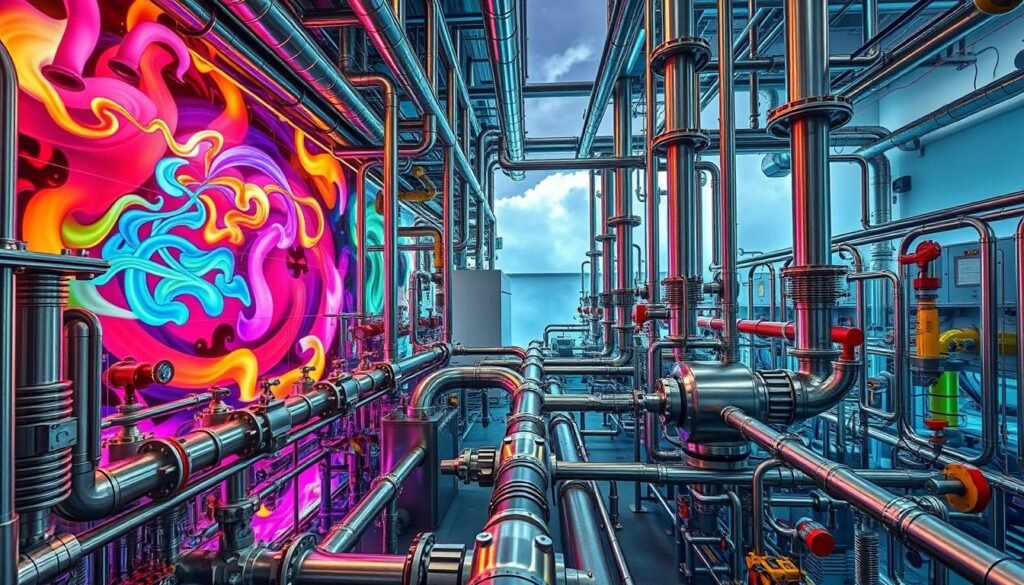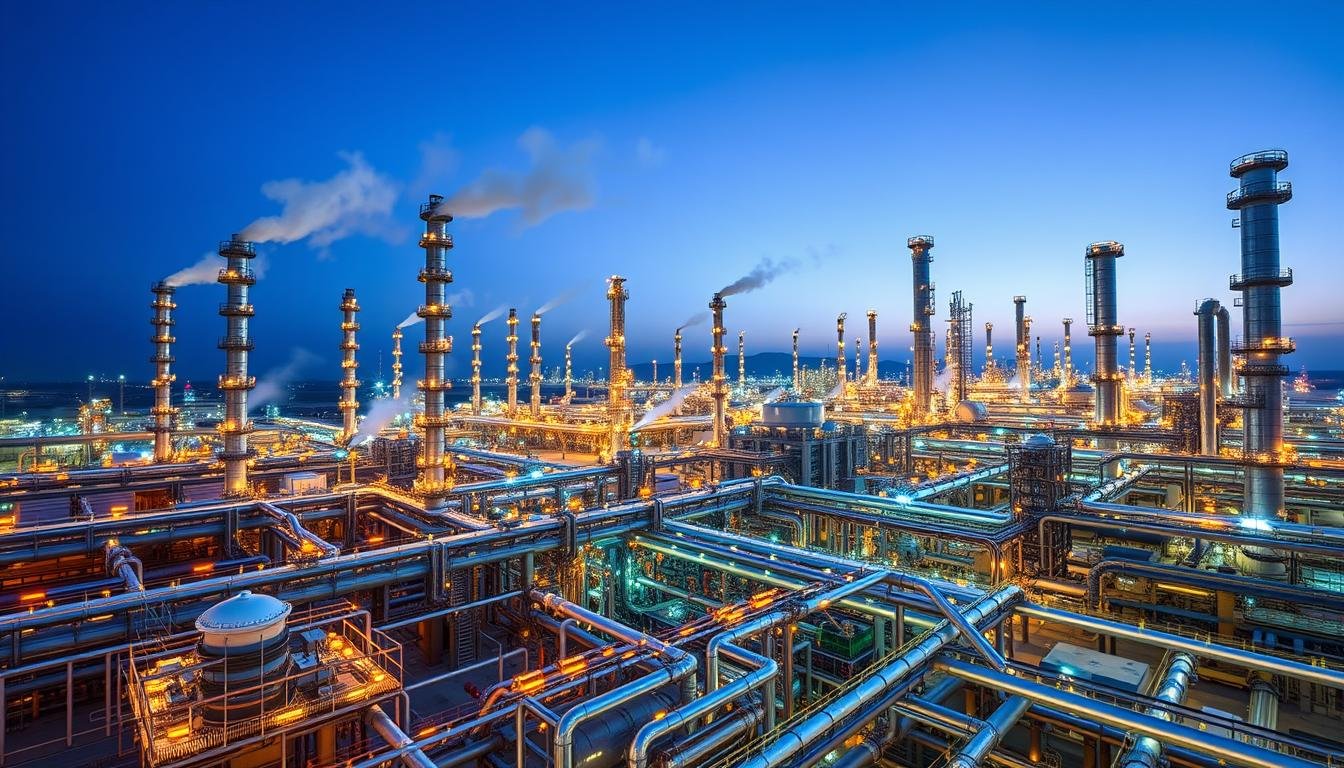Chemical plants are key in the global chemical industry, adding about $4.7 trillion each year. Are chemical plants do efficient reactions? Efficiency is essential, especially as they produce many of the chemicals needed in manufacturing and construction. With growing regulations and demand for environmentally-friendly products, enhancing reaction efficiency is increasingly important.
Improving efficiency helps reduce waste, minimize energy consumption, and lower emissions, all while maintaining high production rates and quality standards. Understanding are chemical plants do efficient reactions is crucial for a sustainable and productive chemical industry.
Key Takeaways
- Chemical plants generate trillions in revenue annually.
- Maximizing reaction efficiency is essential for sustainability.
- Efficient chemical manufacturing helps reduce operational waste.
- Lower energy consumption can lead to decreased greenhouse gases.
- Maintaining product quality is crucial during reactions.
Table of Contents
What is Chemical Plants
Chemical plants are key in the chemical industry. They turn raw materials into products through various processes. Their goal is to make new materials by changing chemicals through reactions.
Petrochemical plants are often near oil refineries to save on shipping costs. Specialized chemical plants, like fine chemical facilities, are smaller and don’t need specific locations.
Chemical plants use two main ways to make products: batch production and continuous operation. Batch production is common in making medicines and specialty chemicals. It allows for better tracking and flexibility. Continuous operation is best for making common chemicals. It keeps the process going without stopping.
Keeping chemical plants running smoothly is important. Chemical engineers aim for 90% uptime for plants handling fluids and 80% for those handling solids. Plants are often designed with big, strong cylinders to handle high temperatures and pressures.
Chemical reactors are at the heart of chemical plants. They change compounds, sometimes using solid catalysts that need to be refreshed. Good separation processes, like filtering and distilling, are key. Heat exchangers help control temperatures.
Fluid systems, like pipes and pumps, move liquids and gases around the plant. Sensors check temperature and pressure. Chemical engineers make sure plants run well and safely. Their work helps make the chemical industry more sustainable.
The Importance of Reaction Efficiency in Chemical Manufacturing
Reaction efficiency is key in chemical manufacturing. It affects both sustainability and profits. Efficient reactions use less energy and make less waste.
This helps cut down on greenhouse gas emissions. These emissions are a big problem today.
High reaction efficiency means lower energy costs. But, balancing reactions is tricky. It can lead to unwanted products and heat issues.
Gas buildup and vessel pressure problems are serious. They can cause small issues or big explosions. It’s vital to know these risks to keep everyone safe.
In 2021, the chemical sector’s emissions were about 925 million metric tons of CO2. We must keep working on making reactions more efficient. This is crucial for meeting new rules and what society expects.
Using Chemical Reaction Hazards (CRH) analysis is a smart move. It includes early studies and reaction calorimetry. These help spot dangers and make processes better.
Chemical Reaction Optimization Algorithms (CROA) are also a big step forward. They help make reactions more efficient. By tweaking temperature and pressure, engineers can find the best conditions.
Looking ahead, improving reaction efficiency is very important. It’s not just about saving money. It’s also about cutting down on harmful emissions. Working on efficiency shows we care about the planet and want a better future for chemical making.
Understanding How Chemical Plants Achieve Efficient Reactions
Chemical plants use new ways to make reactions better. They focus on optimizing reactors for chemical reactions. This makes more of what they want and less of what they don’t.
They also use advanced control systems. This lets them watch and change things as needed. This keeps the process running smoothly and the quality high.
Catalysts play a big role too. They help reactions happen without using too much energy. For example, the Haber-Bosch process for making ammonia shows how good catalysts can be.
New materials like nitrogen-doped graphene with cobalt are being explored. They could make reactions even more efficient. There’s also a push for using less expensive materials that are better for the planet.
So, using smart tech and data is key. It helps make decisions that save energy and meet strict rules.
Factors Influencing Chemical Process Efficiency
Many influencing factors affect how well chemical processes work. Temperature and pressure are key. Changing these can greatly change how fast reactions happen. This can make more product and use less energy.
Adding catalysts also makes reactions faster. This helps make the process more efficient. It’s important to adjust these factors to get the best results in chemical plants.
The quality of the starting materials is also important. It affects how well the process works and the quality of the final product. Companies can use techniques like pinch analysis to cut down on waste and energy use. Using advanced sensors and feedback systems helps keep things running smoothly.
Trying different temperature, pressure, and reactant amounts can help find the best conditions. Using less raw material and finding ways to save energy can also help. This can lead to big savings.
Using renewable energy like solar and wind is a good idea. It helps the environment and meets new rules on carbon emissions. Using green chemistry and lean manufacturing practices is also important. It makes things safer and more sustainable.
For more information on how to improve chemical processes, check out this link. It talks about the latest research and ways to stay competitive in the chemical industry.
| Influencing Factor | Impact on Efficiency | Strategies for Optimization |
|---|---|---|
| Temperature | Affects reaction rates and yields | Regular monitoring and adjustment |
| Pressure | Influences gas-phase reactions, increases efficiency | Optimized reactor design |
| Catalysts | Accelerates reactions, reduces energy usage | Continuous catalyst evaluation |
| Feedstock Quality | Determines overall product quality | Investment in high-quality materials |
Are chemical plants do efficient reactions and what drives them?

Chemical plants are amazing at making reactions happen fast. They use special helpers called catalysts to speed things up. This makes them work better, while keeping things safe and green.
Role of Catalysts in Enhancing Reaction Rates
Catalysts are key to fast reactions. They help reactions go faster without changing themselves. This means plants can make more stuff without using too much energy.
Plants pick the right catalyst for each job. This helps in making everything from oil to medicines better.
Impact of Temperature and Pressure on Chemical Reactions
Temperature and pressure really matter in chemical reactions. Higher temperatures make molecules move faster. This leads to more reactions happening.
Changing pressure can also change how reactions work. Plants adjust these to get the best results. Finding the perfect mix of temperature and pressure is important. It helps plants work better and use less energy.
Innovative Solutions for Optimizing Reactor Performance
In the world of chemical making, new ideas are key to better reactor performance. New designs in catalytic converters and ways to make processes more intense help a lot. These changes help make more product and use less energy.
Advanced Catalytic Converter Design
New catalytic converter design aims to make more room for reactions. Using better materials and shapes, designers boost how well reactions work. This makes chemical making faster and greener by using less waste and energy.
Implementation of Process Intensification Strategies
Process intensification means doing more in one step. Tools like CFD help make reactors work better by improving flow and heat. Model predictive control (MPC) systems also help manage temperature and pressure, making reactors more efficient.
| Innovation Type | Description | Benefits |
|---|---|---|
| Catalytic Converter Design | Maximizes reaction surface area through advanced materials | Increases reaction speed and yields while reducing waste |
| Process Intensification | Integrates multiple production phases to streamline processes | Reduces energy inputs and overall process time |
| MPC Systems | Allows precise control of reactor conditions | Enhances process safety and variability reductions |
Integrating Green Chemistry Techniques in Chemical Plants
Today, green chemistry in chemical plants is a big step towards being more eco-friendly. Using safer materials and reducing waste are key parts of this change. It makes chemical making better for the planet and more efficient.
Many industries, like pharma and food, are moving towards green chemistry. Pharma companies make medicines with less harm to the environment. Food and drink industries use eco-friendly packaging to cut down on waste and save energy.
The energy sector is also changing with green chemistry. It helps make cleaner energy storage systems. But, there are still hurdles like high costs and changing how people think.
Wanhua Chemical is leading the way with big investments in research. In 2023, they spent 4.08 billion yuan on R&D. They focus on new technologies to make chemicals better for the planet.
Looking ahead, we expect big improvements in making chemicals in a green way. Scientists are working on new materials and ways to make things. Working together, we can make chemical making a key part of being green.
Sustainable Manufacturing Practices to Improve Efficiency
Sustainable manufacturing is key for better efficiency in chemical plants. It aims to cut down on environmental harm while boosting productivity. By recycling, using green energy, and doing life cycle assessments, plants can greatly reduce CO2 emissions.
Atom economy is a big part of sustainable making. It’s about using as little waste as possible in chemical reactions. It also means using raw materials more efficiently. The e-factor helps measure how green a chemical process is by looking at waste versus product.
Heat integration saves a lot of energy in making things. It reuses heat, cutting down costs and energy use. Heterogeneous catalysts speed up reactions and make it easier to separate and reuse materials, making things greener.
In-process recycling is also crucial. It lets plants reuse materials, reducing waste. Ionic liquids are great for dissolving many substances, helping in green chemistry. These steps help chemical plants meet green goals and work better.
Energy-Efficient Unit Operations in Chemical Processes
Energy-efficient unit operations change chemical manufacturing. They cut down energy use, helping the environment and saving money. Learning about these methods has shown me how to make chemical processes sustainable.
Reducing Carbon Footprint Through Renewable Energy Sources
Using renewable energy in chemical plants cuts down carbon emissions. Solar, wind, or biomass energy makes plants more green. This change also lowers energy costs over time.
Predictive analytics help use renewable energy better. This boosts efficiency in energy-saving operations.
Waste Minimization Methods and Their Benefits
Reducing waste is key to better process efficiency. Reusing by-products and improving recycling lowers waste. This also saves money and helps the environment.
I suggest looking for ways to cut waste. This makes operations more sustainable.
Using renewable energy and reducing waste makes chemical manufacturing better. It meets economic and environmental goals. For more on managing environmental challenges, check out effective control methods during your transition.
Conclusion
Boosting reaction efficiency in chemical plants is a big chance and challenge. Looking at the future of making things, using sustainable practices is key. It helps make things better and meets people’s needs for green products.
Investing in new reactor designs and green chemistry is smart. It helps these plants stay ahead in a tough global market.
The chemical industry creates about 4.1 million jobs in the U.S. It’s very important for our economy. But, countries like China are investing in chemistry too. This could challenge the U.S. in some areas.
To stay ahead, we need to support research funding and policies. This will attract the best international scientists. It helps us make new discoveries in chemistry.
As we go forward, finding a balance is key. We need to use less energy and cut down on carbon. The chemical and petrochemical industries used a lot of energy in 2016.
By using energy wisely and sustainable ways, we can do well. We can make things efficiently and also take care of the planet.




